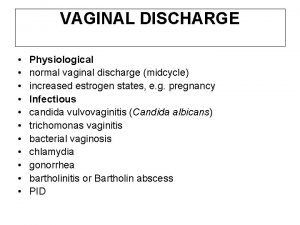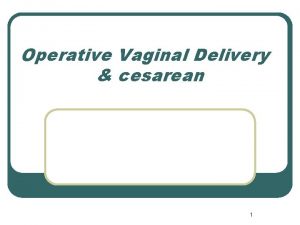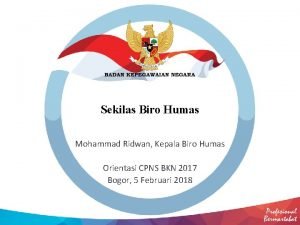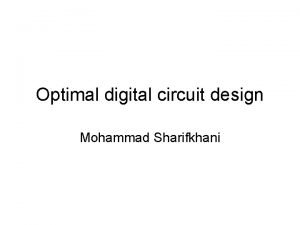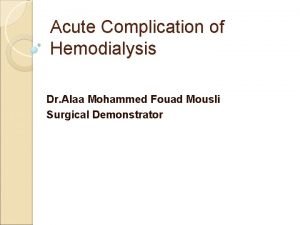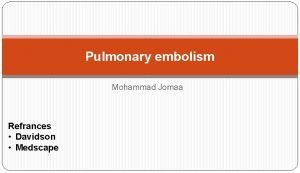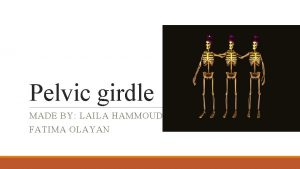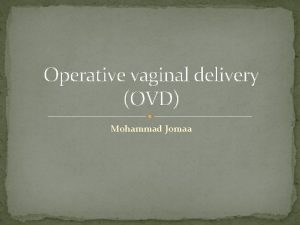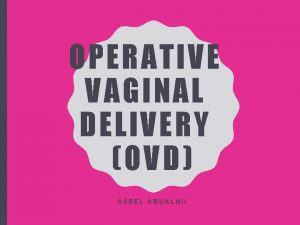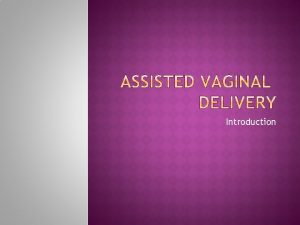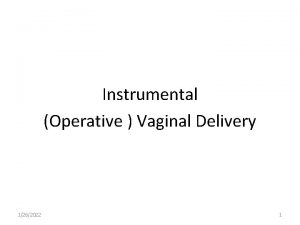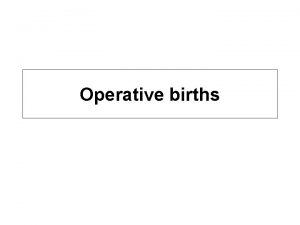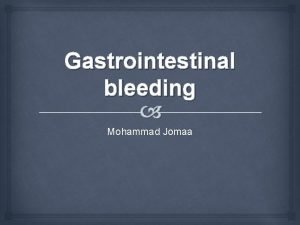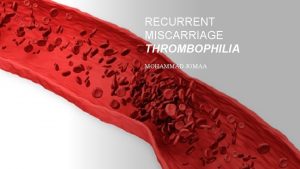Operative vaginal delivery OVD Mohammad Jomaa Operative vaginal















- Slides: 15

Operative vaginal delivery (OVD) Mohammad Jomaa

Operative vaginal delivery (OVD) � Operative vaginal delivery (OVD) refers to a vaginal birth with the use of any type of forceps or vacuum extractor (ventouse) � OVD = instrumental delivery = assisted vaginal delivery � In the UK, between 10% and 15% of deliveries are assisted with forceps or ventouse. The rate in nulliparous women is as high as 30%. The incidence of OVD varies widely both within and between countries. � The goal of OVD is to expedite delivery with a minimum of maternal or neonatal morbidity

Indications �The indications for OVD can be divided into fetal or maternal, although in many cases these factors coexist. Ø The most common fetal factor is suspected fetal compromise, usually based on a pathological cardiotocograph (CTG). Ø The most common maternal factor is a prolonged active second stage of labour. The underlying aetiology for a prolonged second stage should be evaluated in terms of the 3 Ps. It may relate to inefficient uterine activity or poor maternal pushing (‘powers’), short maternal stature, a less favourable pelvic shape or a tight perineum (‘passages’) and a macrosomic fetus, malposition or malpresentation (‘passenger’). A mismatch between the passages and the passenger may result in cephalopelvic disproportion (CPD).

� Meconium: is the earliest stool of a mammalian infant. composed of materials ingested during pregnancy: intestinal epithelial cells, mucus, amniotic fluid, bile and water can cause “Meconium aspiration” � Diagnosis : before birth (low heart rate in the baby before birth, meconium or dark green streaks or stains in the amniotic fluid) or after birth (problems with breathing, low Apgar score and discoloration of the baby's skin)

Contraindications � A careful assessment should take place to ensure that the safety criteria for OVD have been fulfilled. When the safety criteria are not met, OVD is contraindicated. � Safety criteria for operative vaginal delivery consist of: A. Full abdominal and vaginal examination (Head is minimal palpable per abdomen, Cervix is fully dilated and the membranes ruptured, Station at level of ischial spines or below, position of the head, Caput and moulding is no more than moderate) B. Preparation of mother (Informed consent, Appropriate anaesthesia, Empty maternal bladder and Remove in-dwelling catheter or balloon deflated) C. Preparation of staff (Operator, Adequate facilities, Back-up plan “caesarean section”, Anticipation of complications, Trained in neonatal resuscitation) � Forceps and vacuum extractor deliveries before full dilatation of the cervix are contraindicated

Procedure q. Evaluation �confirm whether or not the basic safety criteria for OVD have been met. �A careful pelvic examination is essential to determine whethere any ‘mechanical’ contraindications to performing an OVD. �Consideration must be paid to determining the type of instrument to be employed or whether it may be more prudent to perform a caesarean section. q. Analgesia �Analgesic requirements are greater forceps than for ventouse delivery

q. Positioning �OVDs are traditionally performed with the patient in the lithotomy position. The angle of traction needed requires that the bottom part of the bed be removed. q. Contingency �With any OVD there is the potential for failure with the chosen instrument and the operator must have a backup plan for such an event. �It may be possible to complete a failed vacuum delivery with forceps, but failed forceps delivery will almost always result in caesarean section.

Instrument types q. Ventouse/vacuum extractors � The basic premise of vacuum extraction is that a suction cup, of a silastic or rigid construction, is connected, via tubing, to a vacuum source then direct traction can then be applied to the presenting part coordinated with maternal pushing to expedite delivery. v Technique � Soft vacuum cups are significantly more likely to fail to achieve vaginal delivery than rigid cups; however, they are associated with less scalp injury. � There appear to be no difference in terms of maternal trauma.

�Recent developments have removed the need for external suction generators and have incorporated the vacuum mechanism into ‘hand-held’ pumps (e. g. Omni-Cup) �It is not acceptable to use a ventouse when: The position of the fetal head is unknown. 2. There is a significant degree of caput that may either preclude correct placement of the cup or, more sinisterly, indicate a substantial degree of CPD. 3. The operator is inexperienced in the use of the instrument 1.


q. Forceps � Obstetric forceps are metal instruments consist of two blades with shanks used to provide traction, rotation, or both to the fetal head so different type of forceps arise � The role of episiotomy at vacuum and forceps delivery is controversial with conflicting studies reported ü Episiotomy: is a surgical incision of the perineum performed during the second stage of labour to enlarge the vulval outlet and assist vaginal birth

Complications � There has been an increase in litigation relating to OVD � It is important to know that caesarean section, particularly in the second stage of labour, also carries significant morbidity and implications for future births � OVDs with both vacuum and forceps can be associated with significant maternal and fetal complications. q Maternal Complications Ø Maternal deaths have been reported with vacuum deliveries as a result of cervical tearing in women delivered before full dilatation. Ø Traumatic and non-traumatic vaginal delivery is considered to be the most important risk factor fecal incontinence (anal sphincter injury is twice as common with forceps delivery compared to ventouse). Ø PPH and Under-estimation of blood loss is more common in women needing OVD compared to women who deliver spontaneously, but less common than in women delivered by caesarean section in the second stage.

q Fetal Complications � The morbidities for the baby differ with a higher incidence of cephalhaematoma and cerebral haemorrhage with ventouse and a higher incidence of lacerations and facial palsy with forceps. �Risks of trauma to the baby correlate with the duration of the operative delivery. �It is important to remember that the risks of traumatic injury significantly increase among babies who are exposed to multiple attempts at both vacuum and forceps delivery

�The ventouse compared to forceps is significantly more likely to be associated with: (ventouse side effect) 1. Failure to achieve a vaginal delivery. 2. Cephalo-haematoma (subperiosteal bleed). 3. Retinal haemorrhage. �The ventouse compared to forceps is significantly less likely to be associated with: (forceps side effect) 1. Use of maternal regional/general anaesthesia. 2. Significant maternal perineal and vaginal trauma. 3. Severe perineal pain at 24 hours.

 Rvd ovd
Rvd ovd Criteria for normal vaginal delivery
Criteria for normal vaginal delivery Indication of vacuum delivery
Indication of vacuum delivery Dr mohammad khan
Dr mohammad khan Mohammad ali abtahi
Mohammad ali abtahi Mohammad ridwan bkn
Mohammad ridwan bkn Mohammad sharifkhani
Mohammad sharifkhani Mohammad keshavarz
Mohammad keshavarz Mohammad ali javidian
Mohammad ali javidian Alaa mohammad fouad
Alaa mohammad fouad Dr mohammad aman
Dr mohammad aman Mohammad irfan bowdoin
Mohammad irfan bowdoin Mohammad davidson
Mohammad davidson Mohammad ghoreishi
Mohammad ghoreishi Bones of pelvic girdle
Bones of pelvic girdle Dr nur mohammad hadi zahalan
Dr nur mohammad hadi zahalan

